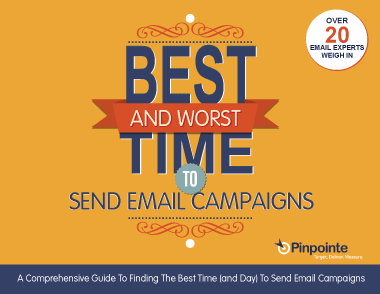Email marketing, out of all marketing strategies, is still a dominant force in marketing. Many organizations have gone global and require the ability to take their email marketing campaigns to the global stage. If this is the case for your company, there’s a lot of things you need to get right. One of which is email localization. Email localization is the process of adapting content in your email marketing campaign to make it more relevant to readers who speak and read a different language or live in a different country. With the help of localization services, you’ll be on your way to a stellar global email marketing campaign!
What Makes Email Marketing Unique Compared to Other Marketing Strategies?
As a marketing platform, email marketing is fraught with challenges and headaches. Yes, email marketing nowadays is made easier with email marketing services such as Pinpointe, but a lingering challenge in email marketing stems all the way back to the basics; how to make the write emails that people would want to click and read.
Most people treat their email inbox like their own office – clutter-free and presentable. That being said, a lot of people are uncompromising when it comes to organizing their inbox. They prefer to keep relevant emails and discard spammy and irrelevant ones before even opening them. That brings us to one of the main goals of email marketing – growing your subscriber list and retaining your subscribers. Yet, that requires different strategies. First off, you need to create engaging and relevant emails that people want to open, read, and not throw away. Sounds simple enough. But countless email marketers around the world are always experimenting and refining their email marketing strategies.
Working With A Translation Company To Prepare Your Emails For Your Global Email Marketing Campaign
You can’t start a global email marketing campaign without translating your emails for obvious reasons. Translating emails isn’t as straightforward as people might think. A lot of people assume that Google Translate, Microsoft Translator, or any other free online translator will do the trick. Sadly, most of the time they’ll end up with horrible results.
Even with sophisticated software, it’s still only useful for single words and short common phrases. In the end, to get quality translated emails, you have to get in touch with a professional translator. You can look for one in freelance networking sites such as Upwork and Fiverr, or from a professional translation company. There’s nothing wrong with freelance networking sites and there are indeed plenty of talented quality freelance professional translators there. But, if your freelance translator gets sick or runs into an emergency, then you’re in a bind. You also have to consider the volume of translation work you need to get done.
As an email marketer, you have multiple campaigns you’ll need to send out for different purposes. With a professional translation company, they can gather not just one, but a team of translators for you. Essentially, you will be able to take advantage of their global networks and company resources to handle your translation jobs. But ultimately, it depends on your budget, how many emails you need to get translated, and if you have tight deadlines.
Isn’t Email Translation Enough?
It actually isn’t. Now, I know that making quality translated emails is difficult enough, but in reality, you just got over the initial steps in preparing for a global email marketing campaign. The next thing you have to do is optimize your campaign for your target audience. But before we get into that, we need to look at why translation, in general, isn’t a guarantee of not only accurate but also appropriate results.
There are thousands of official languages spoken in the world and each one of them sports its own regional differences in the form of dialects. Take a look at English; American English is different from British English, Canadian English, and Australian English. They can comprehend each other but it’s easy to tell where they’re from judging by the accents, choice of vocabulary, and spelling. Of course, your translator already knows this but adhering to linguistic nuances isn’t the only thing you have to worry about. This is where localization comes in, specifically email localization.
What is Localization and How Does it Apply To Emails?
Localization, in all of its many shapes and forms, is plainly adapting content for a specific audience. The best recipe for cross-linguistic and cross-cultural communication is mixing together translation and localization. But as with translation, localization isn’t as simple as its definition suggests.
Localization is about taking note of your target audience’s culture, traditions, and other areas that matter to them. Of course, you get to decide which of these factors you need to pay attention to that might affect your email’s content and its marketing message. Nevertheless, your goal is to create locally relevant emails and promote locally relevant content. By doing so, your emails will resonate well among them, thereby increasing your click-through rates.
Another thing you have to worry about is email etiquette. Yes, that’s really a thing. Email etiquette is part of the bigger picture of cross-cultural customer support. Many cultures have specific attitudes towards emails and how one ought to structure one and respond to it.
For example, American emails are usually more frank and informal. But German and Japanese emails that emphasize hierarchy not only should use formal language but should also be delegated to the organization’s level of the hierarchy. This means you can’t send emails directly to the CEO without going through people under him. But since we’re talking about email marketing here and you’re contacting your subscribers directly, you don’t need to worry about that. However, you still have to be mindful of the tone you use and which specific type of tone (formal or informal) will work for your subscribers.
Read on to find out what else goes into a good email localization strategy…
Best Practices in Email Localization You Can Adopt
1) Incorporating Local Linguistic Nuances
We already went over this, but here are some extra details about linguistic nuances. This is one of the many areas that people fail when localizing, or at the very least, translating their emails. Now, templates are fine and everyone uses them, but some rely on them a bit more than others. It’s easy to detect an email template a mile away and it’s as clear as day when a translated email is coming from a stale master template. This is why you need to get in touch with a translation company and professional translators. They have local knowledge of which words and phrases are appropriate to use that Google Translate can’t do. Your goal is to create localized conversations. You can do this by incorporating more linguistic nuances i.e. slang, humor, local vocabulary, expressions, etc. By doing so, you are humanizing the email’s voice and your email will come off as legitimate rather than spam.
2) Optimizing Your Email’s Aesthetics (Color Choices and Typography Layout)
Many cultures around the world have different perceptions of colors. For instance, some cultures associate red with wealth and happiness but others view it as a color that signifies evil and danger. The choice of colors you employ is crucial in a successful email localization strategy.
Another thing with aesthetics is typography. This also falls under linguistic nuances since some of your translations will be written in foreign writing systems. But in this context, it’s how you layout your typography that falls under this category. In translation, there’s a thing called word count ratio. Many languages incorporate more words into their sentences. So when you’re translating from English to Spanish, English to Chinese, English to Russian, etc., your translated layout will look very different from the original English master version. This won’t usually matter in some emails, but if you’re sharing digital media in your emails that are character sensitive, you can’t ignore this. Have your translator and graphic designer work together so that each translated digital media has a perfectly optimized layout.
3) Time Zones
Since you’re sending your emails to a foreign audience, you have to remember that they’re also living in different timezones. In email marketing, there are specific times of the day that people are more apt to open their emails. With your chosen email marketing service, you have to schedule your emails and sync it with each of your foreign subscriber’s time zones.
4) Local Email Regulations
Not a lot of people know about this but many countries have regulations on sending emails. Email regulations exist to stop spammers and discourage legitimate marketers from committing unethical marketing tactics such as misleading subscribers with misleading subject lines.
If you need specifics, here’s a list of a few countries and their respective email laws
- America – CAN-SPAM Act
- United Kingdom – Privacy and Electronic Communications Regulations
- Canada – Anti-Spam Law
- Australia – Spam Act of 2003
- European Union – Directive on Privacy and Electronic Communications
- China – Regulations on Internet Email Services
- Japan – Act on Regulation of the Transmission of Specified Electronic Mail
- South Korea – Act on Promotion of Information and Communication Network Utilization and Information Protection
Don’t Forget To Also Provide Multilingual Support
When you send out multilingual emails, your foreign email subscribers will naturally reply back to you in their native language. This is also another reason why a lot of people don’t try to global email marketing since you need to have all levels of the process in order. These include translating and localizing your emails, to having the capacity to respond and cater to multilingual email subscribers in their native language.
After knowing this, don’t give up just yet! If you don’t have in-house multilingual employees, that’s perfectly fine. You can easily outsource your multilingual customer service. Again, this depends on your business objectives and whether or not one of your multilingual employees can handle the job. But if you’re global email marketing campaign covers multiple countries, not only do you need to outsource your multilingual customer service on account of volume but you can reduce your costs that way. Many multilingual customer service providers allow their clients to tailor their customer service requirements. Depending on your customer service needs, you can simply opt for live chat services or immediately choose to provide voice support. You can add more options such as email support services, social media support services.
Where Do I Get the Best Email Localization Services?
Now that you know how much goes into email localization, is it a good choice to take care of it on your own? In the same way you need a professional translator for your email translation jobs, you also need an email localization expert.
To get the best localization assistance get in touch with a localization company. If you think that it’s too much of a hassle to contact one more service provider, you’re in luck because many professional translation companies are also known as localization companies. They’ve built their reputation in providing both translation and localization services.
When you ask for localization services, specify that you’re looking for email localization services. Localization is a broad concept that applies to nearly all global industries and their operations, not just marketing. Common localization services include marketing localization, website localization, and software localization. With the range of localization services they offer, it’s not hard to find a localization company/translation company that offers email localization services.
Email Marketing Is Here to Stay: Final Takeaway
Emails are actually older than the Internet itself. But up to this day, it’s definitely still a widely used medium, not just in marketing, but also in global communication! There’s just something about emails…even with social media and instant messaging, it’s hard to imagine global communication without it.
So if you’re wondering whether or not email localization, much less email marketing is worth the hassle, it’s probably a good idea not to think so. Emails are here to stay. So, doing your email marketing and email localization right with the help of a translation company/localization is well worth the investment.






